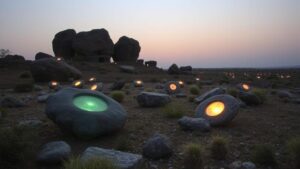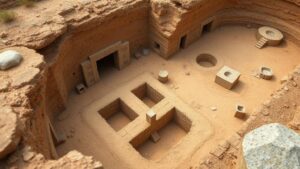Exploring the myth of King Solomon’s Mines and their possible location.
Exploring the Myth of King Solomon’s Mines and Their Possible Location
For centuries, the legend of King Solomon’s Mines has captivated explorers, historians, and treasure hunters alike. Rooted in biblical history and African lore, these mythical mines are said to be a treasure trove of gold and precious gems that once belonged to the biblical King Solomon. The quest to locate these mines and uncover their mysteries remains a fascinating subject of discussion.
The Historical Context
King Solomon, depicted in the Hebrew Bible as a wealthy and wise ruler, is believed to have ruled over the Kingdom of Israel during the 10th century BCE. According to biblical texts, specifically in the Book of Kings, Solomon utilized vast amounts of gold for temple construction and other royal endeavors, making his reign synonymous with wealth.
The myth of the mines likely stems from Solomon’s extensive trade networks and the natural wealth of regions such as Ophir, which some scholars speculate may have been a source of gold. While the exact location of Ophir is debated, it has been associated with places such as modern-day Somalia, Yemen, and the Indian subcontinent.
The Legendary Mines
The quintessential tale of King Solomon’s Mines was popularized by the 1885 novel written by H. Rider Haggard. This literary work combined elements of adventure and mystery and introduced numerous readers to the idea that hidden riches could be found in the heart of Africa. According to Haggards narrative, the mines were located in a lost civilization ruled by the character Umbopa, who sought to reclaim his rightful throne.
Possible Locations for King Solomon’s Mines
The quest for the actual location of Solomon’s fabled mines has led many to consider several potential sites across Africa. Below are some locations that have been proposed:
- The Richtersveld in South Africa – Known for its diamond deposits, this arid region has been suggested due to its wealth of mineral resources.
- The Mountains of the Moon in Uganda – Some believe these mountains, also known as the Rwenzori Range, house untold riches.
- The Lake Victoria Basin – This region is rich in gold and has been historically significant in the trade of precious minerals.
- Ophir – While its precise location remains a mystery, various biblical scholars have connected it to regions along the East African coast.
Real-World Applications
The allure of King Solomon’s Mines is not merely an artifact of legend; it serves as a catalyst for exploration and economic development. search for resources like gold and diamonds often leads to significant advancements in mining technology and practices.
In contemporary times, the mining industry in Africa contributes substantially to national economies. For example, in 2019, South Africa alone accounted for roughly 7.3% of global gold production. Also, the lessons learned from the exploration of mythical locations can influence sustainable mining practices, environmental regulations, and community engagement in areas rich with natural resources.
Conclusion and Actionable Takeaways
The legend of King Solomon’s Mines continues to inspire curiosity and adventure, transcending historical and geographical boundaries. While concrete evidence of Solomon’s mines remains elusive, the stories surrounding them highlight the significance of exploration and the enduring human fascination with treasure.
For those intrigued by history, archaeology, or the mining industry, consider the following actionable takeaways:
- Investigate further into the historical and biblical texts regarding King Solomon’s reign.
- Explore current mining practices and their impacts on local communities in regions previously associated with wealth and treasure.
- Participate in or support archaeological explorations that seek to uncover the historical truths behind legends like King Solomon’s Mines.
Ultimately, the quest for King Solomon’s Mines is a narrative woven with myth, history, and the universal desire to uncover the unknown, making it a continuing journey worth embarking on.



